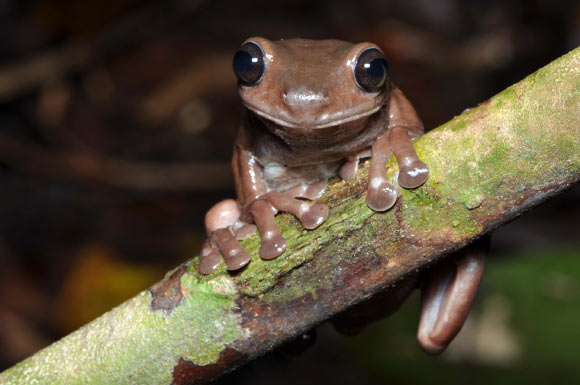A team of researchers led by Griffith University has described a new species of the Australasian tree frog genus Litoria from the rainforests of New Guinea.
Litoria is a large genus of tree frogs native to Australia, the Bismarck Archipelago, the Solomon Islands, New Guinea, the Lesser Sunda Islands, and the Moluccan Islands.
The genus includes over 90 species and belongs to the monotypic subfamily Litoriinae in the family Pelodryadidae.
The newfound species, named Litoria mira, is endemic to New Guinea and widespread in lowland swampy rainforest.
“Once we saw the new species, we started calling it a chocolate frog and the name stuck,” said Dr. Paul Oliver, a researcher at Queensland Museum and Griffith University.
“The closest known relative of Litoria mira is the Australian green tree frog (Litoria caerulea).”
“The two species look similar except one is usually green, while the new species usually has a lovely chocolate coloring.”
“What’s a little surprising about this discovery is that the well-known and common green tree frog of Australia has a long-overlooked relative living in the lowland rainforests of New Guinea,” he added.
“Because of this we named the new frog Litoria mira because the word Mira means surprised or strange in Latin.”
“Because the frog lives in very hot, swampy areas with lots of crocodiles, all these things discourage exploration,” said Dr. Steve Richards, a researcher at the South Australian Museum.
“While New Guinea is not a place most Australians know well; many animal groups are shared.”
“So understanding biodiversity in New Guinea helps us to understand the history and origins of Australia’s unique fauna.”
While Australia and New Guinea were linked by land for much of the Late Tertiary epoch (2.6 million years ago) and share many biotic elements, New Guinea is now dominated by rainforest, and northern Australia by savannah.
“Resolving the biotic interchange between these two regions is critical to understanding how the rainforest and savannah habitat types have the expanded and contracted over time of both,” Dr. Oliver said.
“Estimates for divergence of the new species in our study shows that in the Pliocene (5.3 to 2.6 million years ago) there was still connectivity between the two species the across lowland tropical habitats of northern Australia and New Guinea.”
“These results emphasize that the extent and connectivity of lowland rainforest and savannah environments across northern Australia and southern New Guinea and the profound shifts the region has undergone since the Late Pliocene epoch.”
A paper describing the discovery appears in the Australian Journal of Zoology.
_____
Paul M. Oliver et al. 2021. Multiple trans-Torres Strait colonisations by tree frogs in the Litoria caerulea group, with the description of a new species from New Guinea. Australian Journal of Zoology 68 (1): 25-39; doi: 10.1071/ZO20071








